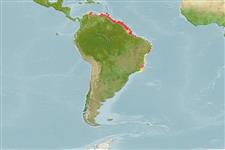>
Siluriformes (Catfishes) >
Ariidae (Sea catfishes) > Ariinae
Etymology: Cathorops: Greek, kathorao = to observe, to watch + Greek, ops = appearance (Ref. 45335); spixii: The name is dedicated to the ichthyologist of the 19th century, J.B. de Spix (Ref. 35381).
More on author: Agassiz.
Issue
Taylor & Menezes (1977) indicate that two or more species may be included here.
Environment: milieu / climate zone / depth range / distribution range
Ecologia
marinhas; estuarina demersal; intervalo de profundidade 1 - 50 m (Ref. 5217). Tropical; 13°N - 23°S, 77°W - 34°W
Western Atlantic: Atlantic and Caribbean rivers and estuaries from Colombia to Brazil.
Length at first maturity / Tamanho / Peso / Idade
Maturity: Lm 16.4, range 10 - 22.4 cm
Max length : 30.0 cm TL macho/indeterminado; (Ref. 3265); common length : 20.0 cm TL macho/indeterminado; (Ref. 3265); peso máx. Publicado: 97.50 g (Ref. 118626)
Descrição breve
Chaves de identificação | Morfologia | Morfometria
3 pairs of barbels on rostral region, 2 pairs on lower jaw, 1 pair on posterior end of maxilla; body dark brown or black dorsally, pale yellow ventrally; fin membranes brown, with small black spots (Ref. 13608). Head is widely flattened from above, nostril rounded, mouth inferior. The cephalic surface hardly reaches the level of the eyes (Ref. 35381).
Found in shallow coastal marine waters and brackish estuaries, lagoons and river mouths. Also in hypersaline waters (Ref. 5217). Feeds mainly on invertebrates and small fishes. Juveniles feed on amphipods, isopods and copepods (Ref. 35381). Flesh considered good quality (Ref. 5217). Sold locally.
Life cycle and mating behavior
Maturities | Reprodução | Spawnings | Egg(s) | Fecundities | Larvas
Marceniuk, A.P. and C.J. Ferraris Jr., 2003. Ariidae (Sea catfishes). p. 447-455. In R.E. Reis, S.O. Kullander and C.J. Ferraris, Jr. (eds.) Checklist of the freshwater fishes of South and Central America. Porto Alegre: EDIPUCRS, Brasil. (Ref. 39852)
Categoria na Lista Vermelha da IUCN (Ref. 130435)
Ameaça para o homem
Traumatogenic (Ref. 58010)
Utilização humana
Pescarias: pouco comercial
Ferramentas
Relatórios especiais
Descarregue XML
Fontes da internet
Estimates based on models
Preferred temperature (Ref.
123201): 24.9 - 28.2, mean 27.4 °C (based on 118 cells).
Phylogenetic diversity index (Ref.
82804): PD
50 = 0.5000 [Uniqueness, from 0.5 = low to 2.0 = high].
Bayesian length-weight: a=0.00724 (0.00611 - 0.00858), b=3.04 (2.99 - 3.09), in cm total length, based on LWR estimates for this species (Ref.
93245).
Nível Trófico (Ref.
69278): 3.5 ±0.1 se; based on diet studies.
Resiliência (Ref.
120179): Elevada, tempo mínimo de duplicação da população menor que 15 meses (Preliminary K or Fecundity.).
Fishing Vulnerability (Ref.
59153): Low vulnerability (20 of 100).
Nutrients (Ref.
124155): Calcium = 122 [59, 299] mg/100g; Iron = 1 [1, 2] mg/100g; Protein = 17 [15, 19] %; Omega3 = 0.267 [0.142, 0.513] g/100g; Selenium = 44.3 [21.0, 99.1] μg/100g; VitaminA = 37.5 [12.6, 116.5] μg/100g; Zinc = 1.71 [1.12, 2.74] mg/100g (wet weight);
